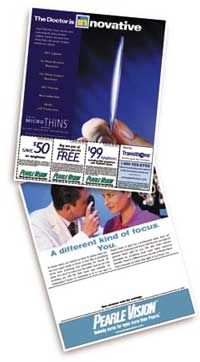How the Chains Are Positioning Lenses By Erinn Morgan They sell large amounts of prescription lenses to a growing number of the people in need of them. There-fore, optical chain stores may be a good barometer to the directions of the marketplace. We interviewed four chains for their widespread perspective, each with different focuses and markets. The roundup includes: ShopKo, a mass market retailer with close to 170 stores located primarily in the Midwest; Standard Optical, a regional chain with 16 stores in Utah; Pearle, a national chain with close to 900 locations; and Optical Shop of Aspen, a high-end chain with 11 locations in California, Arizona, Colorado, Kansas, and New Mexico.
Turning up the Heat In the chains, it seems that the three Ps are the most successful categories: Polycarbonate, progressives, and polarized. When asked which area is growing the fastest, most of these chains pointed to polycarbonate as the biggest area of profitability. "Our poly continues to build and not just with kids," says Jerry Ziefle, lens buyer at ShopKo. "It is a requested product by consumers now. The educational stuff has had its effects." "We have converted 65 percent of our lenses into polycarbonate," says Aaron Schubach, director of marketing and the lab manager/lens buyer for Standard Optical, which charges $124.95 for single vision polycarbonate lenses. "Poly is what we recommend to customers." At Pearle, a full-scale "relaunch" of polycarbonate is underway. Dispenser training is also part of the project. "We had nice increases due to the marketing efforts we put behind it," says Lauren Arnold, Pearle's spectacle lens product manager. However, on the high end, polycarbonate does not seem to be as strong of a contender. "We don't sell much poly," says Jerry Thornhill, lens buyer for Optical Shop of Aspen. "We do it for sports glasses but not that much for regular prescription lenses." On the progressives front, these retailers are also seeing increases. "We are benefiting from the continued growth in the number of presbyopes," says ShopKo's Ziefle. "But bifocals and trifocals are still 25 percent of our business, however, because the Midwest mentality is still somewhat traditional." Some attribute their recent progressive success to new lens designs. "The smaller progressives are doing real well for us," says Thornhill. "Because right now we are really selling a lot of small frames." And others say it is the flexibility of new customers. "We are fitting 99 percent of our new presbyopes into progressives," says Schubach. "It's easier for them to go right into the no-line products." Finally, the third real success story in the optical chain lens department this year is polarized product. "It's a good category. We do some dispenser training and consumer education about its benefits," says Arnold. "And there is definitely a lot more room for growth there. You just have to get people to try it once and they will get hooked." Still, some believe that there is confusion regarding the category. "We've done a good job with polarized, but it isn't growing at the rate I think it should," says ShopKo's Ziefle. "There's a lot of chatter and hype about it, but the industry hasn't really done a good job with consumers to communicate the benefits. It's definitely an area that could grow."
Layering it On Lens coatings and treatments are also strong contenders for business at optical chains. In fact, these days, many say they carry lenses that come standard with AR coating or scratch resistant coating. And this tactic is quite successful. "We automatically give customers lenses that feature a factory scratch coat," says Thornhill. "We were one of the first outfits that went with factory scratch coat completely in 1987." Optical Shop of Aspen also does a high percentage of AR coating on the lenses they sell-about 50 to 65 percent. The success of this end of the lens business even prompted some retailers to reorganize their offerings. "A couple of years ago we took a look at how we were handling all of our coatings and applications," says Ziefle. "We wanted to work with independent labs so we could ascertain which is the best. Now we only offer premium coatings." For the most part, these retailers do not find value in packaging or bundling lens treatments. Standard Optical, however, takes a different tactic. "We really believe in packaging everything together," says Schubach. "We call that our 'Masterpiece Lens System' and when we package the items, the customer saves about $50." In addition to coatings, most chain retailers agree that photochromic lenses continue to be strong sellers.
Which areas are predicted to see continued success? From Pearle's perspective, several areas are pegged for future growth, including AR, polarized lenses, and shorter progressives. "There are new things coming in AR that will help increase this business even more-new technology and increased consumer awareness," says Arnold. And others point to different categories. "The higher indexes will grow in the future," says Thornhill. "Everybody's looking for thinner and lighter. And polarized will continue to grow, too. With a positive business climate and new technology and products coming down the pike, most chains predict a successful year 2000 in retail spectacle lens sales. EB
|
Article
How the Chains Are Positioning Lenses
Eyecare Business
July 1, 2000





